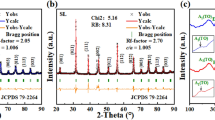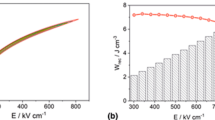Abstract
Electrical breakdowns of multilayer ceramic capacitors (MLCCs) manifest an increase in leakage current and are characterized as a function of atmospheric reoxidation. The atmospheric reoxidation is controlled with respect to the theoretical oxygen partial pressure for the oxidation of Ni internal electrodes. The breakdowns are characterized by a Maxwell–Wagner polarization technique, which dominantly exhibits space-charge-limited and Poole–Frenkel currents for all measured samples. The threshold voltage for the transition between these two conduction modes is suggested as an index for the robustness of the grain boundary resistance of BaTiO3; therefore, the breakdown voltage. The reoxidation atmosphere, which prevents the Ni oxidation, increases the threshold voltage, dramatically enhancing the breakdown voltage and insulation resistance. Impedance spectroscopy and scanning transmission electron microscopy–energy-dispersive X-ray spectroscopy reveal that the cation distribution throughout BaTiO3 grains and grain boundaries changes during the reoxidation, including Ni cations from the internal electrodes, which affects the grain boundary resistance and determines the breakdown voltage of MLCCs with Ni internal electrodes. These observations emphasize that the reoxidation should be concurrently optimized in terms of the cation redistribution and elimination of oxygen vacancies.





Similar content being viewed by others
References
M. Stengel, D. Vanderbilt, N.A. Spaldin, Enhancement of ferroelectricity at metal–oxide interfaces. Nat. Mater. 8, 392–397 (2009). https://doi.org/10.1038/nmat2429
M. Dawber, K.M. Rabe, J.F. Scott, Physics of thin-film ferroelectric oxides. Rev. Mod. Phys. 77, 1083–1130 (2009). https://doi.org/10.1103/RevModPhys.77.1083
R. Waser, T. Baiatu, K. Hardtl, DC electrical degradation of perovskite-type titanates: I, ceramics. J. Am. Ceram. Soc. 73, 1645–1653 (1990). https://doi.org/10.1111/j.1151-2916.1990.tb09809.x
S. Sumita, M. Ikeda, Y. Nakano, K. Nishiyama, T. Nomura, Degradation of multilayer ceramic capacitors with nickel electrodes. J. Am. Ceram. Soc. 74, 2739–2746 (1991). https://doi.org/10.1111/j.1151-2916.1991.tb06837.x
M.R. Opitz, K. Albertsen, J.J. Beeson, D.F. Hennings, J.L. Routbort, C.A. Randall, Kinetic process of reoxidation of base metal technology BaTiO3-based multilayer capacitors. J. Am. Ceram. Soc. 86, 1879–1884 (2003). https://doi.org/10.1111/j.1151-2916.2003.tb03576.x
Y.-M. Chiang, T. Takagi, Grain-boundary chemistry of barium titanate and strontium titanate: I, high-temperature equilibrium space charge. J. Am. Ceram. Soc. 73, 3278–3285 (1990). https://doi.org/10.1111/j.1151-2916.1990.tb06450.x
R. Waser, M. Klee, Theory of conduction and breakdown in perovskite thin films. Integr. Ferroelectr. 2, 23–40 (1992). https://doi.org/10.1080/10584589208215729
S. Rodewald, J. Fleig, J. Maier, Resistance degradation of iron-doped strontium titanate investigated by spatially resolved conductivity measurements. J. Am. Ceram. Soc. 83, 1969–1976 (2000). https://doi.org/10.1111/j.1151-2916.2000.tb01499.x
M. Vollman, R. Waser, Grain boundary defect chemistry of acceptor-doped titanates: space charge layer width. J. Am. Ceram. Soc. 77, 235–243 (1994). https://doi.org/10.1111/j.1151-2916.1994.tb06983.x
H.-I. Yoo, C.-E. Lee, Two-fold diffusion kinetics of oxygen re-equilibration in donor-doped BaTiO3. J. Am. Ceram. Soc. 88, 617–623 (2005). https://doi.org/10.1111/j.1551-2916.2005.00123.x
W. Preis, W. Sitte, Electronic conductivity and chemical diffusion in n-conducting barium titanate ceramics at high temperatures. Solid State Ionics 177, 3093–3098 (2006). https://doi.org/10.1016/j.ssi.2006.07.053
J. Itoh, I. Yashima, N. Ohashi, I. Sakaguchi, H. Haneda, J. Tanaka, Ni ion diffusion in barium titanate perovskite. J. Ceram. Soc. Jpn. 109, 955–959 (2001). https://doi.org/10.2109/jcersj.109.1275_955
S.K. Das, R.N. Mishra, B.K. Roul, Magnetic and ferroelectric properties of Ni doped BaTiO3. Solid State Commun. 191, 19–24 (2014). https://doi.org/10.1016/j.ssc.2014.04.001
I. Stolichnov, A. Tagantsev, Space-charge influenced-injection model for conduction in Pb(ZrxTi1−x)O3 thin films. J. Appl. Phys. 84, 3216–3225 (1998). https://doi.org/10.1063/1.368888
K. Lee, B.R. Rhee, C. Lee, Leakage current-voltage characteristics of ferroelectric thin film capacitors, J. Kor Phys. Soc. 38, 723–728 (2001). https://www.jkps.or.kr/journal/view.html?uid=4426&vmd=Full
G.M. Kale, D.J. Fray, Oxygen potentials in Ni + NiO and Ni + Cr2O3 + NiCr2O4 systems. Metall. Mater. Trans. B 25, 373–378 (1994). https://doi.org/10.1007/BF02663386
H. Hu, S.B. Krupanidhi, Current–voltage characteristics of ultrafine-grained ferroelectric Pb(Zr, Ti)o3 thin films. J. Mater. Res. 9, 1484–1498 (1994). https://doi.org/10.1557/JMR.1994.1484
W. Osak, K. Tkacz, Investigation of I–V characteristics in polycrystalline BaTiO3, J. Phys. D: Appl. Phys. 22, 1746–1750 (1989). https://iopscience.iop.org/article/10.1088/0022-3727/22/11/028.
D.J. Wouters, G.J. Willems, H.E. Maes, Electrical conductivity in ferroelectric thin films. Microelectron. Eng. 29, 249–256 (1995). https://doi.org/10.1016/0167-9317(95)00155-7
B. Nagaraj, S. Aggarwal, T.K. Song, T. Sawhney, R. Ramesh, Leakage current mechanisms in lead-based thin-film ferroelectric capacitors. Phys. Rev. B 59, 16022–16027 (1999). https://doi.org/10.1103/PhysRevB.59.16022
S.-H. Yoon, S.-H. Kim, D.-Y. Kim, Correlation between I (current)–V (voltage) characteristics and thermally stimulated depolarization current of Mn-doped BaTiO3 multilayer ceramic capacitor. J. Appl. Phys. 114, 074102 (2013). https://doi.org/10.1063/1.4818947
Y. Sakabe, Y. Hamaji, H. Sano, N. Wada, Effects of rare-earth oxides on the reliability of X7R dielectrics, Jpn. J. Appl. Phys. 41, 5668–5673 (2002). https://iopscience.iop.org/article/10.1143/JJAP.41.5668/meta.
A.I. Lebedev, I.A. Sluchinskaya, On the nature of change in Ni oxidation state in BaTiO3−SrTiO3 system. Ferroelectrics 501, 1–8 (2016). https://doi.org/10.1080/00150193.2016.1198196
T. Yoshida, T. Tanaka, H. Yoshida, T. Funabiki, S. Yoshida, Study on the dispersion of nickel ions in the NiO−MgO system by X-ray absorption fine structure. J. Phys. Chem. 100, 2302–2309 (1996). https://doi.org/10.1021/jp952526p
H. Kishi, Y. Okino, M. Honda, Y. Iguchi, M. Imaeda, Y. Takahashi, H. Ohsato, T. Okuda, The effect of MgO and rare-earth oxide on formation behavior of core-shell structure in BaTiO3, Jpn. J. Appl. Phys. 36, 5954–5957 (1997). https://iopscience.iop.org/article/https://doi.org/10.1143/JJAP.36.5954/meta.
R.A. De Souza, A.H.H. Ramadan, Ionic conduction in the SrTiO3|YSZ|SrTiO3 heterostructure. Phys. Chem. Chem. Phys. 15, 4505–4509 (2013). https://doi.org/10.1039/C3CP44399J
R.A. Maier, C.A. Randall, Low-temperature ionic conductivity of an acceptor-doped perovskite: I. Impedance of single-crystal SrTiO3. J. Am. Ceram. Soc. 99, 3350–3359 (2016). https://doi.org/10.1111/jace.14348
R.A. Maier, C.A. Randall, Low temperature ionic conductivity of an acceptor-doped perovskite: II. Impedance of single-crystal BaTiO3. J. Am. Ceram. Soc. 99, 3360–3366 (2016). https://doi.org/10.1111/jace.14347
S. Taibl, G. Fafilek, J. Fleig, Impedance spectra of Fe-doped SrTiO3 thin films upon bias voltage: inductive loops as a trace of ion motion. Nanoscale 8, 13954–13966 (2016). https://doi.org/10.1039/C6NR00814C
Acknowledgements
D. Lee thanks Soojeong Jo at Samsung Electro-Mechanics for the MLCC samples used in this study.
Author information
Authors and Affiliations
Corresponding author
Ethics declarations
Conflict of interest
The authors declare no competing financial interests.
Additional information
Publisher's Note
Springer Nature remains neutral with regard to jurisdictional claims in published maps and institutional affiliations.
Rights and permissions
About this article
Cite this article
Lee, D., Song, K., Jung, D. et al. Characterizing electrical breakdowns upon reoxidation atmosphere for reliable multilayer ceramic capacitors. J. Korean Ceram. Soc. 58, 445–451 (2021). https://doi.org/10.1007/s43207-021-00121-9
Received:
Revised:
Accepted:
Published:
Issue Date:
DOI: https://doi.org/10.1007/s43207-021-00121-9




